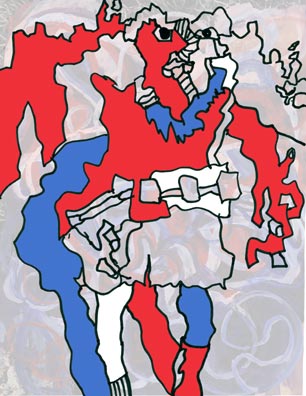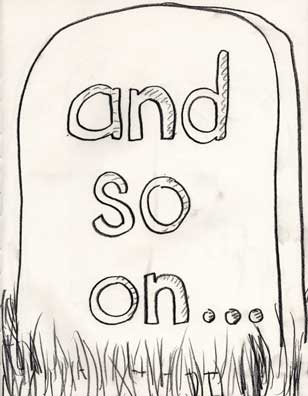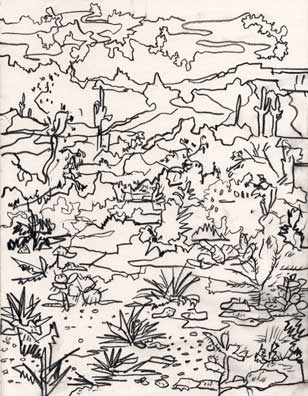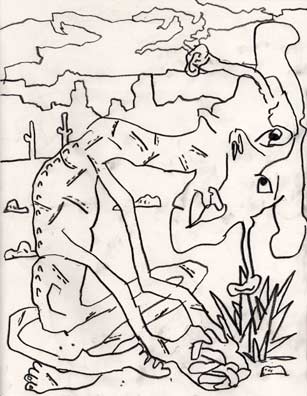
 |

I was racking my brain in search of a concise, worthwhile post when I realized - as I always realize, eventually, in such circumstances - that it's the racking that causes the problem.
On the occasion of the Museum of Modern Art’s great Jackson Pollock retrospective in 1998, I recall reading a particular review of the exhibit in one of the local papers. Suitably in awe of Pollock’s accomplishment, the reviewer led us through the rooms of the show. For many at the time, the final gallery of works was a cause of ill-ease, sadness and disappointment. Coming after the towering breakthrough of the drip paintings and the powerful black and white figurative paintings that followed, the works in the last room of the show appeared to some as disparate, tangential and flailing.
The reviewer in question was among those who found the conclusion to the show, and Pollock’s oeuvre, wanting. The writer said, in essence, that the probable trajectory of this painter's work was easy to imagine. He/she then proceeded to envision the unlived remainder of Pollock’s career - going so far as to describe precise (imagined) paintings complete with names for different (imagined) series'. This writer’s conjectured future for the artist undermined the credibility of the previous (actual) work and, ultimately, implied that Pollock’s premature death was a sort of blessing in that it spared us from having to look at a lot of lousy late-career paintings and spared him from becoming a parody of himself.
Concocting a future for a unique artistic genius is, of course, rampant and a fool’s mission.
It’s possible that, had Pollock not wrapped that car around a tree, he might have had a breakthrough to rival the drip paintings. Unimaginable, to be sure, but no more improbable than the emergence of the drip paintings in the first place - a development that no one could have predicted. They only seem self-evident post their physical manifestation.
With the above story as a cautionary tale, John Currin’s mid-career survey at the Whitney - perhaps because it represents the tantalizing beginning of a life’s work - got me thinking about where he might take us and his work. In contradistinction to the above author’s imagining of a future body of Pollock’s work, Currin’s future of my imagining would seem rife with possibilities that may recast everything we suppose about his present undertaking.
Currin’s work-to-date is predicated on the notion that, in fact, a reactionary approach can be the more progressive strategy. Painting in a highly accomplished realist manner is the reactionary part of the equation. When it comes to the progressive side of the calculation, though, Currin hasn’t shown his cards.
Despite a reputation that characterizes his work as intentionally vulgar, misogynistic or kitschy, what Currin seems most intent to do is reassure. The quality of his paintings register as an objective fact. They are uncommonly well painted, undeniably “good” paintings. To put it bluntly, nobody walks away from a Currin painting saying “my kid could do that.” Or, to employ a metaphor frequently used with Currin: How can the emperor have no clothes if they’re painted so well and I can, in fact, see them with my own eyes?
In an age given to cynicism and overload, this assurance of quality is an experience in rare supply. Its appearance comes as a kind of relief; aesthetic resistance falls. With the viewer’s judgment suspended by this assurance, the painting is perceived, allowing image and content to come to the fore. One of Currin’s great accomplishments is that his paintings have found an opening.
Building upon the strategy of providing reassurance through satisfying reactionary yearnings, Currin makes academic paintings catered to the moment. With a nod to the canon, his works draw their sources from the visual imagery in which the culture is fluent - that is to say the academy of our time - hence, the indebtedness to pinups, porn, fashion magazines and Rockwell inspired illustration and sentimentality.
The people who populate Currin’s paintings are from what one might call the collector class. Like the academic painters of old, he is explicitly appealing to the taste of his audience by (symbolically) painting his patrons. True to tradition, he does this, in effect, by holding up a mirror. This strategy sets up the vexing and indelicate question, “Is getting everything you want the definition of crap?”
In "Fishermen" (2002) the two figures are up to their thighs in a tiny, little boat that, as per conventional anatomy, can’t possibly contain the rest of their lower bodies. Effectively, they have “boat legs.” Boat legs...boot legs. A bootleg of tradition, tweaking the notion of proprietary originality and asking, "Would you download this file?"
The gallery label accompanying “Fishermen” takes care to direct our attention to the virtuosic rendering of the rope looped in the foreground. Often, Currin’s work is presented as a chance to practice old time connoisseurship, an opportunity to deploy the magnifying glass to scrutinize and delight over technical prowess. Thus far, this kind of fetishism has accompanied the appreciation of Currin’s paint handling. In time, though, Currin’s vaunted painting technique may be revealed to be a feint in service to his progressive ends. Technique, representing seemingly measurable, verifiable quality, may be a kind of trojan horse admitting nothing short of mastery into the mix.
In recent years, mastery as a concept and ambition has suffered a conflation with patriarchy and exclusivity. In some ways, this reappraisal would appear reactionary in the extreme. Yet, mastery doesn’t reside on any political or aesthetic spectrum. It is the constant, a wellspring. In its best sense, mastery - meaning the fluid manifestation of intent - is the province of every individual’s unique genius.
The Whitney’s gallery guide quotes Currin as saying, “The subject of a painting is always the author, the artist.” Indicative of Currin’s strategy of redirection, this statement raises the question: When standing before a painting on a gallery wall, who is the authority? The painter, nowhere to be seen, back at work on a new painting in his or her studio, or the viewer presently experiencing the work?
If we are content with marveling over technical virtuosity, then we cede authority to the absent artist. However, if it is mastery we find, we can meet the painting with our own unique genius, in effect becoming the artist. The mirror-like aspects of Currin’s work - which have been seen, in the main, as reflecting back to us our cultural tastes and desires - intimate that this bit of aesthetic jujitsu, wherein the viewer is empowered into their own artistry, is the progressive end of his enterprise.

"epitaph"
Lately (as per the previous post), I have had the delight to be in the company of a young person learning to write. Currently she recognizes all the letters and can accurately depict them. Placing those letters in a word-making arrangement is the approaching horizon.
Watching her practice, provides a reminder that handwriting is drawing. Before written words can convey meaning an image must be constructed. Learning to master handwriting is an early, formative experience of what we might call "realistic drawing." The instructive irony, of course, is that making marks that register as words - words that only exist in the mind and who's communicative meaning is completely dependent on consensus - is about as abstract as it gets.
Today's posted drawing is an example from an ongoing body of work I refer to as "word paintings."

"nearly_show_share"
Today's post is currated by the discerning eye of a four and a half year old. While traveling, I was graciously welcomed into the family home of beloved friends in Pheonix. My prescence there became the pre-school "Show and Share" subject of the family's oldest daughter.
Reports are that "Alice" described me as "an artist who takes walks in the desert and makes drawings." When asked what the drawings look like, her succinct answer, "swirly."
My young friend's presentation resulted in her getting some pre-school homework, namely to see if she might be able to bring in one of those "swirly" drawings to share with the class.
Could there be a more desirable audience than a classroom of 4 year olds? Eyes whose youthful survey is fresh and without judgement. Perception independent of aesthetics.
I did, however, call upon Alice to make a critical assessment: to select which drawing she would like to take to class and show her friends. After removing images that might be regarded as disturbing, I offered her many drawings from which to choose. The above posted drawing drew her immediate and unwavering enthusiasm. "That's the one I want to take to school," she said.
The piece is unique in the works I showed Alice in not featuring a human figure, and is easily the most representational drawing I made during my stay in Pheonix (possibly the most representational drawing I've made in 15 years!). It could, essentially, be the view out the back of her family's home. (Actually, I made it sitting across from the Convention Center in downtown Phoenix.)
Addendum: Happily, I can report that, in today's unveiling, the drawing earned winning approval for itself and its presenter. In fact, the story may well continue, for the teacher plans to make photocopies of the drawing for the kids to color and then send to the "artist."
I'll keep you apprised.

"wiped_homespun_Sedona"
Tucked away in the U.S. Forest Service guide for Red Rock Country, Coconino National Forest and Sedona, Arizona is a reference to a Northern Arizona University survey which found in a recent year that 64% of those visiting the area came seeking a spiritual experience of some sort. Sedona's towering wind and rain sculpted rock formations annually receive four million visitors - “a large number considering the prime attraction is rust,” quips the guide. (The rocks contain iron oxide which through exposure to the elements over millions of years has oxidized, giving the stone its signature blazing orange cast.)
Laid down in the Paleozoic Era, the rock formations of Sedona are the remains of what was once the bedrock upon which the first terrestrial life forms put down roots. As those plants and amphibians ascended, the land undergirding their development slowly surrendered to countless eons of relentless wind and rain – a process of pure creative destruction resulting in the fantastic forms remaining at this moment.
For visitors, the lure is a landscape whose beauty is a function of its decay. This is in striking counterpoint to the situation in the valley where surging urban development is creating a new environment and even newer decay. Like history’s greatest tsunami, humans are, in effect, accelerating the impact of countless eons of weather.
In the same way that one could think of the Red Rocks as the infrastructure upon which terrestrial life built its paradise, so the human development which now fills Sedona’s valley, climbs its mountains and - come to think of it - encircles the globe is the infrastructure suited to our perceived needs and purposes. It feels, here, as though humanity is an alighting hitchhiker saying to the undergirding rocks, “thanks for the ride, but we’ll take it from here.”
Where will this unprecedented endeavor deliver us? How can we successfully negotiate the shoals to escape catastrophe and emerge as richer, wiser, worthy heirs of our earthly progenitor?
Perhaps an answer lies with that 64% who visit Sedona in quest of spiritual experience.
The rise of art making as a human activity (truly a new thing under the sun) dates to about 40,000 years ago. Its appearance is an event that, not coincidentally, roughly coincides with the emergence of the first deleterious impacts of human activity on the environment – for example the hunting to extinction of certain large mammals.
Perhaps the making of art is an evolutionary adaptive response fashioned to re-inject beauty and meaning into a world suffering from human-induced environmental stress. The ongoing genius revelation of our art-making ancestors is that creativity is the ultimate renewable resource.
To the extent that access to the beauty and sustenance of the natural world diminishes, the need for beauty and its orienting connection to awe increases in proportion - awe being the healthy default of human nature. As human activity compromises the inherited beauty of the natural world, we find it biologically incumbent to create beauty from that nature which remains available to us: our own.
From this perspective, those spiritual seekers drawn to Sedona come as nascent artists efforting under the tutelage of the land’s unfathomable beauty to turn yearning into healing.